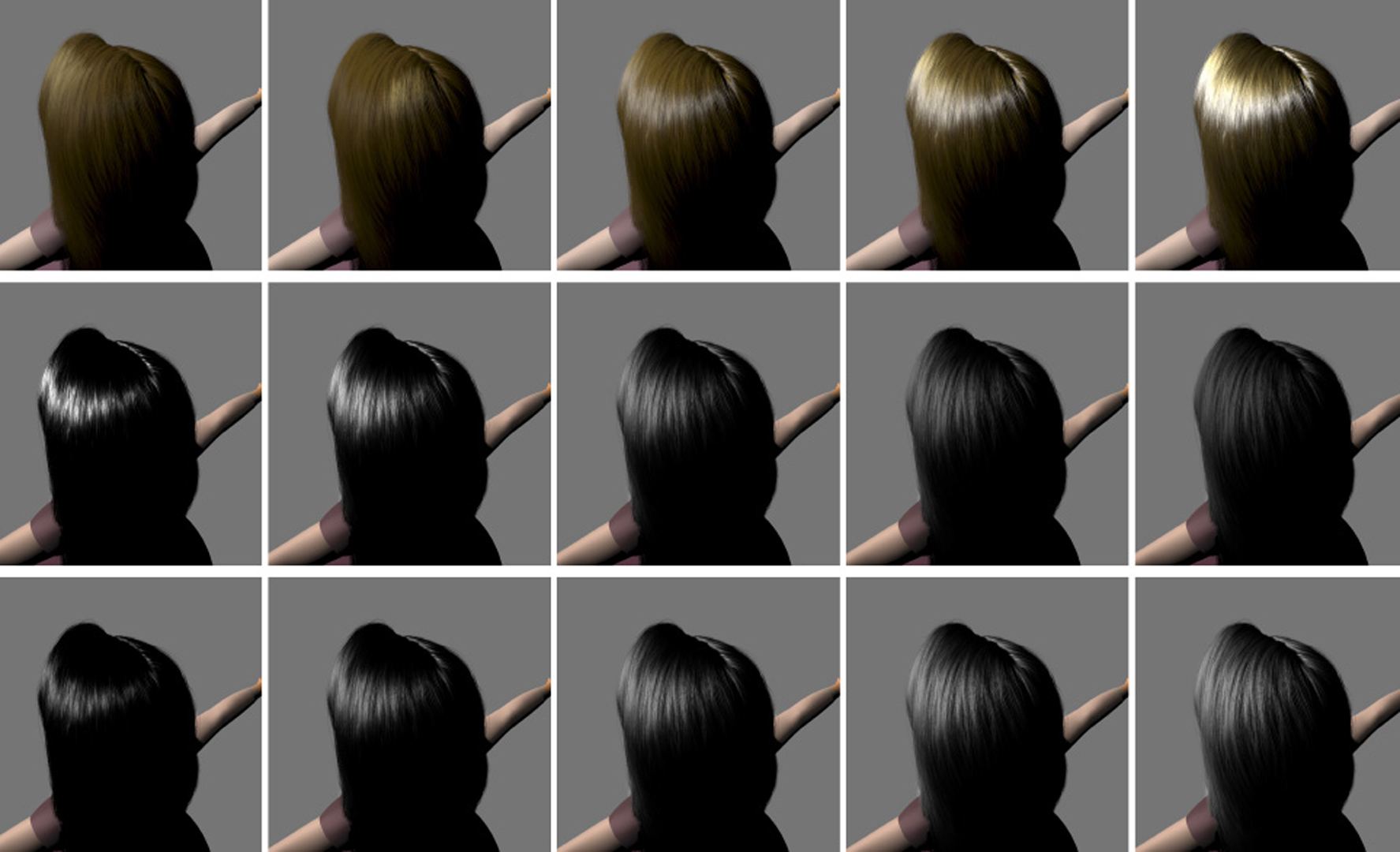“An artist friendly hair shading system” by Sadeghi, Pritchett, Jensen and Tamstorf
Conference:
Type(s):
Title:
- An artist friendly hair shading system
Presenter(s)/Author(s):
Abstract:
Rendering hair in motion pictures is an important and challenging task. Despite much research on physically based hair rendering, it is currently difficult to benefit from this work because physically based shading models do not offer artist friendly controls. As a consequence much production work so far has used ad hoc shaders that are easier to control, but often lack the richness seen in real hair. We show that physically based shading models fail to provide intuitive artist controls and we introduce a novel approach for creating an art-directable hair shading model from existing physically based models. Through an informal user study we show that this system is easier to use compared to existing systems. Our shader has been integrated into the production pipeline at the Walt Disney Animation Studios and is being used in the production of the upcoming animated feature film Tangled.
References:
1. Apodaca, T., Gritz, L., Lancaster, T., Prater, M., and Bredow, R. 2000. Advanced RenderMan 2: To RI_INFINITY and Beyond. SIGGRAPH 2000 Course 40.Google Scholar
2. Apodaca, T., Gritz, L., Pharr, M., Hery, C., Bjorke, K., and Treweek, L. 2001. Advanced RenderMan 3: Render Harder. SIGGRAPH 2001 Course 48.Google Scholar
3. Apodaca, T., Gritz, L., Pharr, M., Goldman, D., Landis, H., Quaroni, G., and Bredow, R. 2002. RenderMan in Production. SIGGRAPH 2002 Course 16.Google Scholar
4. Bonneel, N., Paris, S., van de Panne, M., Durand, F., and Drettakis, G. 2009. Single Photo Estimation of Hair Appearance. Computer Graphics Forum (Proceedings of the Eurographics Symposium on Rendering) 28, 4, 1171–1180. Google ScholarDigital Library
5. Ducheneaut, N., Wen, M.-H., Yee, N., and Wadley, G. 2009. Body and Mind: A Study of Avatar Personalization in Three Virtual Worlds. In CHI ’09: Proceedings of the 27th international conference on Human factors in computing systems, ACM, New York, NY, USA, 1151–1160. Google ScholarDigital Library
6. Goldman, D. B. 1997. Fake Fur Rendering. In Proceedings of SIGGRAPH 97, ACM Press/Addison-Wesley Publishing Co., New York, NY, USA, 127–134. Google ScholarDigital Library
7. Grudin, J. 1993. Obstacles to Participatory Design in Large Product Development Organizations. In Participatory design: principles and practices. L. Erlbaum Associates, Hillsdale, NJ, USA, 99–119.Google Scholar
8. Kajiya, J. T., and Kay, T. L. 1989. Rendering Fur With Three Dimensional Textures. In Computer Graphics (Proceedings of SIGGRAPH 89), ACM, New York, NY, USA, 271–280. Google ScholarDigital Library
9. Kim, T.-Y. 2002. Modeling, Rendering and Animating Human Hair. PhD thesis, Los Angeles, CA, USA. Google ScholarDigital Library
10. Marschner, S. R., Jensen, H. W., Cammarano, M., Worley, S., and Hanrahan, P. 2003. Light Scattering from Human Hair Fibers. ACM Transactions on Graphics 22, 3, 780–791. Google ScholarDigital Library
11. Mihashi, T., Tempelaar-Lietz, C., and Borshukov, G. 2005. Generating Realistic Human Hair for “The Matrix Reloaded”. In SIGGRAPH ’05: ACM SIGGRAPH 2005 Courses, ACM, New York, NY, USA, 17. Google ScholarDigital Library
12. Moon, J. T., and Marschner, S. R. 2006. Simulating Multiple Scattering in Hair Using a Photon Mapping Approach. ACM Transactions on Graphics 25, 3, 1067–1074. Google ScholarDigital Library
13. Moon, J. T., Walter, B., and Marschner, S. 2008. Efficient Multiple Scattering in Hair Using Spherical Harmonics. ACM Transactions on Graphics 27, 3, 31:1–31:7. Google ScholarDigital Library
14. Neulander, I. 2004. Quick Image-Based Lighting of Hair. In SIGGRAPH ’04: ACM SIGGRAPH 2004 Sketches, ACM, New York, NY, USA, 43. Google ScholarDigital Library
15. Norman, D. A., and Draper, S. W., Eds. 1986. User Centered System Design; New Perspectives on Human-Computer Interaction. L. Erlbaum Associates, Hillsdale, NJ, USA. Google ScholarDigital Library
16. Norman, D. A. 2002. The Design of Everyday Things. Basic Books, New York, NY, USA. Google ScholarDigital Library
17. Paris, S., Chang, W., Kozhushnyan, O. I., Jarosz, W., Matusik, W., Zwicker, M., and Durand, F. 2008. Hair Photobooth: Geometric and Photometric Acquisition of Real Hairstyles. ACM Transactions on Graphics 27, 3, 30:1–30:9. Google ScholarDigital Library
18. Petrovic, L., Henne, M., and Anderson, J. 2005. Volumetric Methods for Simulation and Rendering of Hair. Tech. Rep. 06–08, Pixar Animation Studios.Google Scholar
19. Sadeghi, I., and Tamstorf, R. 2010. Efficient Implementation of the Dual Scattering Model in RenderMan. Tech. rep., Walt Disney Animation Studios.Google Scholar
20. Schuler, D., and Namioka, A., Eds. 1993. Participatory Design: Principles and Practices. L. Erlbaum Associates, Hills-dale, NJ, USA. Google ScholarDigital Library
21. Ward, K., Bertails, F., Kim, T.-Y., Marschner, S. R., and Cani, M.-P. 2007. A Survey on Hair Modeling: Styling, Simulation, and Rendering. IEEE Transactions on Visualization and Computer Graphics 13, 2, 213–234. Google ScholarDigital Library
22. Zinke, A., and Weber, A. 2006. Global Illumination for Fiber Based Geometries. In Electronic proceedings of the Ibero American Symposium on Computer Graphics (SIACG).Google Scholar
23. Zinke, A., and Weber, A. 2007. Light Scattering from Filaments. IEEE Transactions on Visualization and Computer Graphics 13, 2, 342–356. Google ScholarDigital Library
24. Zinke, A., Yuksel, C., Weber, A., and Keyser, J. 2008. Dual Scattering Approximation for Fast Multiple Scattering in Hair. ACM Transactions on Graphics 27, 3, 32:1–32:10. Google ScholarDigital Library
25. Zinke, A., Rump, M., Lay, T., Weber, A., Andriyenko, A., and Klein, R. 2009. A Practical Approach for Photometric Acquisition of Hair Color. ACM Transactions on Graphics 28, 5, 165:1–165:9. Google ScholarDigital Library





